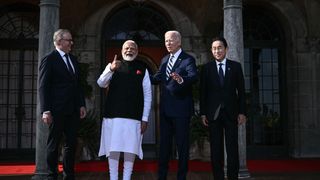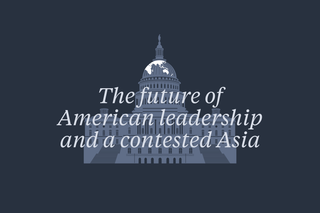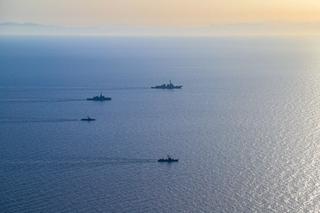Since its revival in 2017, the Quad grouping of Australia, India, Japan and the United States has wrestled with persistent criticisms — bolstered by Chinese disinformation campaigns — that the partnership is little more than an ‘anti-China’ coalition. Nowhere has this narrative been more damaging than in Southeast Asia, where states seek to hedge between the United States and China.
The success of the Quad and its reach and relevance in Southeast Asia depends on its ability to reshape its identity beyond the confines of major power rivalry.
The Quad first emerged in 2004 with a public goods mandate, but its efficacy is yet to be proven. The underperformance of the Quad’s vaccine diplomacy only further undercut efforts to forge the grouping’s identity as a leading public goods provider and demonstrate that the four maritime powers are united behind a positive vision for the region.
But there are also signs of progress when it comes to Association of Southeast Asian Nations (ASEAN) perceptions of the Quad. State of Southeast Asia survey data released in April 2024 shows 40.9 per cent of ASEAN respondents think that the Quad can be beneficial to the region, while only a declining minority remains concerned that the grouping may provoke China (7.4 per cent) or force countries to choose sides (7.9 per cent).
While these statistics provide a useful overview, the reality on the ground is far more complex. ASEAN should not be seen as a monolith, and Southeast Asian countries’ relationships with the Quad are unique and varied. Countries closer to China, such as Cambodia and Myanmar, continue to maintain a more cautious view of the Quad. But in recent months, the Philippines has participated in the newly minted ‘Squad’ — an unofficial variation of the Quad grouping.
Both the Quad and ASEAN aim to foster regional peace and stability by addressing non-traditional security challenges like climate change, humanitarian and disaster relief, public health and security, infrastructure development and digital connectivity. In these early stages of trust building, the Quad must prove it is cooperating rather than competing with ASEAN and its long-held place in the regional diplomatic architecture. The Quad–ASEAN Technology Cooperation for Critical Minerals Supply Chains is an encouraging start.
Expanding the scope and diversifying the voices involved in these discussions is integral to building stronger foundations of trust between the Quad and Southeast Asia and enhancing cooperation on shared lines of effort. The Quad countries could consider developing an annual track two dialogue that convenes leading experts from industry, think tanks, academia, non-governmental organisations and civil society to foster bipartisan continuity for relationships at the non-government level. The dialogue could emulate the Network for East Asian Think-tanks — a track two mechanism of ASEAN Plus Three which supports, promotes and develops ideas of East Asian cooperation and regionalism.
Non-governmental dialogues are already a crucial pillar of the Quad countries’ regional diplomacy. The United States’ bilateral relationships with Australia, Japan and India are underpinned by strong high-level dialogues, including the Australia–American Leadership Dialogue, Mt. Fuji Dialogue and the US–India Strategic Dialogue, jointly held by the Ananta Aspen Centre and the Aspen Strategy Group.
These dialogues have proved an invaluable means to boost cross-sector connectivity and create a functional ‘epistemic community’ of key stakeholders contributing to the diplomatic relationship. If the Quad aims to build trust and cooperation with ASEAN, nurturing this kind of intellectual architecture is a natural next step.
A Quad–ASEAN track two platform could provide a vital forum for ironing out misconceptions about the Quad, building stronger cross-country networks on the ground and coordinating and deconflicting efforts on complementary initiatives across the Quad’s six leader-level working group themes of climate, critical and emerging technology, cyber, health security, infrastructure and space. Such a mechanism would also help to drive local input and ensure the Quad’s public goods agenda is a collaborative effort that is responsive to community needs, rather than something the Quad is delivering to Southeast Asian states.
In every joint statement since 2020, the Quad leaders have affirmed their commitment to ASEAN centrality, even calling for greater collaboration in support of the ASEAN Outlook on the Indo-Pacific. This sentiment was echoed by their foreign policy principals at the Quad Foreign Ministers’ Meeting in late July.
Despite this clear willingness, lingering scepticism about the Quad’s regional position and purpose — and assumed ‘anti-China’ intentions — prevents the minilateral grouping from gaining traction in the region. These reservations are only amplified by the lack of multilateral engagement between the two groupings. An annual Quad–ASEAN track two dialogue could help to allay these concerns by facilitating trust-building and driving progress on shared priorities.
The Quad’s presence needs to be seen as adding vibrancy to the region by providing viable alternatives and healthy competition, rather than through the narrow lens of intensifying major power rivalry. If the Quad wants to build regional buy-in and lay the groundwork for deepened cooperation with Southeast Asia, its ambitions at the leaders’ level need to be matched by stronger connectivity and robust intellectual discourse among non-government players.
This article was written by the USSC's Ava Kalinauskas and Angeline Tan, an analyst at the Institute for Strategic and International Studies Malaysia.









